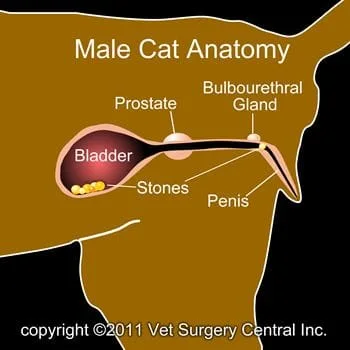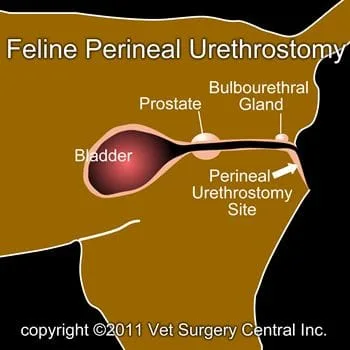Key Points
A warning sign of urinary obstruction is frequent visits to the liter box and straining during urination without production of urine
Emergency veterinary attention is needed to treat this potentially fatal condition
With treatment, the prognosis is favorable

The urinary system is made of the kidneys, the tubes (ureters) that pass urine from the kidneys to the bladder, the bladder which is a reservoir for urine, and the urethra, which is the tube that drains urine from the bladder to the outside. The urethra in males is fairly long and a portion of it runs through the tissue of the penis. The urethra narrows within the penis, which makes it prone to developing obstruction.
What is feline lower urinary tract disease?
An inflammatory, typically noninfectious disease of the bladder in cats, is called feline lower uinary tract desease (FLUTD). Affected felines can have plugs of mucous, crystals, and bladderstones. These can pass from the bladder and into the urethra. The result is urinary obstruction which results in failure of kidney function with a build up of toxins (uremia), acids, and potassium within the blood stream. Left untreated, death ensues within 24 to 48 hours.
Signs
Intitial signs of urinary obstruction includes straining to urinate without producing any urine. The bladder becomes distended to the size of an orange, which is typically easily palpable through the abdominal wall. Crying, moaning in pain, anorexia, vomiting, and seclusion from the family are common nonspecific signs. As toxins build up in the body, the cat will become progessively more depressed until the patient dies.
Diagnosis
Upon physical examiantion, the veterinarian will find a very firm, painful bladder and urine cannot be expressed from the bladder. Radiographs (x-rays) are essential to see if the obstruction of the urethra is due to stones. Blood testing is done to check kidney function (BUN and creatinine), to check for accumulation of acid in the blood and make sure that the potassium levels are not elevated.
Preparation for surgery
Typically cats that present for surgical treatment of urinary obstruction need emergency treatment, therefore, preoperative preparation is usually possible. Prior to surgery, your pet will receive a sedative, have an intravenous catheter placed for the administration of intravenous fluids and intravenous medications, be induced under general anesthesia with medication(s), and have a breathing tube (endotracheal tube) placed to allow delivery of oxygen and gaseous anesthesia. The surgical site will be clipped and cleansed with an anti-septic solution in preparation for surgery. While under general anesthesia, your pet’s breathing will be assisted with a ventilator and vital parameters such as heart rate, respiratory rate, core body temperature, blood pressure, oxygenation of the blood (pulse oximetry), exhaled carbon dioxide (capnography), and heart rhythm (EKG) will be monitored to ensure your companion’s well being. Pain will be controlled both during and after surgery with analgesics (pain-controlling medication).

Immediate treatment of urinary blockage is essential. At the veterinary hospital intravenous fluid therapy will be initiated to correct dehydration. Elevated blood potassium levels must be addressed, as this could cause abnormal heart beats and could stop the heart from beating; this is treated with administration of insulin and intravenous dextrose (sugar). A urinary catheter is used to flush the obstructing mucus plug, crystals, or stone back into the bladder. After the obstruction has been relieved, a urinary catheter is placed and the bladder is flushed with saline. The catheter is left in place for about 24 hours and then it is removed. An additional 24 hours of hospitalization is essential to ensure that the cat is urinating well. Reobstruction of the urethra again require repeating the process of unobstructing the urethra again.
Surgery is indicated if the cat has bladder stones (cystotomy). If the patient has repeated urethral obstruction (typically 3 strikes and your out) with mucous plugs or crystals, then a perineal urethrostomy is performed to remove the narrow terminal part of the urethra located within the penis.
Aftercare
Patients that have a perineal urethrostomy are usually released from the hospital the day after surgery or after the toxins (BUN and creatinine) have been eliminated from the blood stream. An analgesic will be prescribed for about 4 days after surgery to keep the cat comfortable at home. The incision should be checked twice daily however, should not be washed or disturbed as this may cause bleeding and delay healing. Compressed paper litter such as “yesterdays news” litter should be used. Clay litter is not recommended, as it can become caked around the surgical site and cause urinary obstruction. An Elizabethan collar is kept on the patient for about 10 days. Antibiotics typically are continued for about 2 weeks after surgery. When the cat returns to us for suture removal, a very short anesthesia will be needed.
Complications
Complications associated with the urinary obstruction may include an atonic bladder. Complications from surgery include bleeding from the surgery site, infection, urinary or fecal incontinence and stricture of the urethra. The atonic bladder is due to chronic overstretching of the bladder muscle, which results in a bladder that can no longer contract and expel urine. This problem is treated with mediations and urinary catheterization and usually resolves within 7 days after surgery. Bleeding is typically self-limiting and rarely needs treatment other than ensuring that your cat does not disrupt the incision by licking. Bladder infection is the most common complication following surgery and may be due to a shortened urethra. Signs of a bladder infection include blood in the urine, straining to urinate and frequent visits to the litter box. Some cats may have no visible signs of infection; therefore, a urinalysis and urine culture should be done very 3 months by the pet’s veterinarian. Fecal and urinary incontinence are very rare complications that may be a permanent problem; signs of this include involuntary dropping of stools and leakage of urine. Stricture of the urethra at the surgery site is the most devastating complication that occurs within the first 6 weeks after surgery. Warning signs of this complication are the same as those seen with urinary obstruction. Additional surgery attempting to correct this problem is usually successful only 50% of the time.
Prognosis
Most cats that have perineal urethrostomy go on to live a normal and healthy life.
Suggested reading
Degner, DA. Procedures Pro: Urinary obstruction: treatment measures. Clinicians Brief. 9(9):70-75, 2011. (click here); please note that Clinicians Brief is the publisher and copyright holder of this article and they have given permission (11/2911) to share it on www.vetsurgerycentral.com.
rev 10/2/11


